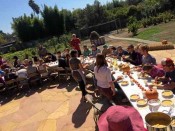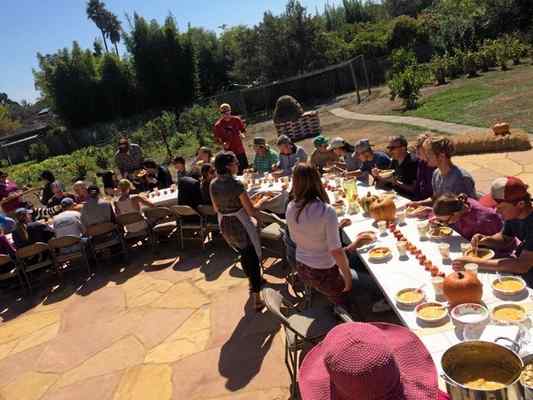Waldorf News
Working toward a better world: Camphill California

By Alliee DeArmond
When my youngest son was a freshman in college, he told me he’d figured out that it took three connections to make a friend. Being in the the same dorm was one connection, having a class together made two, but it took another, third connection, to build friendship. Although he was an early adopter of social media, he wasn’t counting that.
This comment was intriguing in terms of what it takes to build community. It also spoke of the needs and vulnerability of young people. Clearly his major concern was not connecting with the great thinkers, movers and shakers through the centuries, which is presumably what a college education is about, but rather connecting with a few good folk to hang out with.
Given the size of our schools and cities, the lack of cohesive villages or even neighborhoods, fractured families and religious pluralism, our young people are left fumbling about on their own in a milieu where it’s too easy to fall through the cracks and become prey to those with evil designs.
This is not a new problem; read Proverbs, circa 1000 B.C. However, each generation faces new parameters. Today we see on a global scale the havoc, carnage and chaos caused by young people enslaved, coerced and co-opted by those whose agenda is death and destruction. May we create new ways to model, mentor and manifest communities that help our growing children choose life.
Camphill California is an residential community hidden in the hills of Soquel. The first Camphill community was formed in 1939 by a pediatrician Dr. Karl Konig, who, with a group of physicians, artists and caregivers, fled the Nazi annexation of Austria and built a community in Scotland for developmentally disabled children.
Based on Rudolf Steiner’s anthroposophy, which is best known in conjunction with the Waldorf Schools, Konig’s vision was to develop communities that include people with special needs and that develop each person’s particular gifts and abilities. Community members teach, learn and work together, growing within the context of their daily lives. There are currently 100 Camphill communities in 22 countries.
Camphill California in Soquel recruits young adult coworkers who volunteer to spend a year living cooperatively and working alongside adults with special needs. Ranging in age from 21- 35, coworkers live with adult residents in one of the eight houses on the Soquel campus. They learn leadership, communication and caregiving in the context of a community supported by peers and engaged in meaningful work.

Work within the community also teaches specific skills. After a morning gathering, rotating teams perform different responsibilities in the houses and workshops. Weaving, other forms of handwork, agricultural and culinary work take place on seven acres of cultivated land, which includes gardens, orchards and a vineyard. The young adults work side by side with their new friends. Meals are shared in each household and once a week the whole community of around 50 people have lunch together.
Music and artistic activities are central. Afternoons are filled with plays, painting, singing, dramatic readings, therapeutic music, and eurythmy (speech made visible through movement). Individuals are encouraged to take part in artistic activities as a means of self-discovery, relationship building and engaging with the world.
Anthroposophy, which Steiner called, “the science of the spirit,” is a path of self-knowledge whereby following what is spiritual in the human leads to what is spiritual in the universe. Christian symbols encourage people to reflect on their personal path, on the world we live in as spiritual beings and help connect individual relationships with the larger spiritual world. A weekly discussion and reflection period at Camphill California engages with portions of the Bible.
Konig expanded Steiner’s theories to include curative education, social therapy and many kinds of art therapy. Some universities accept the co-workers’ training as credits toward programs in these areas. All the coworkers receive room, board and a stipend; the community functions on the theory that everyone receives what they need and gives back what they are able.
The coworkers are international, currently 12 different countries are represented. Applications for coworker positions begin in January and the work starts in July. I asked Director Elizabeth Barber if the annual change of coworkers is difficult for the residents. She said that they are used to it, and that the influx of eight to 10 new people every year gives a fresh and vibrant energy to the community.
Tours of Camphill California are held every third Thursday. Festivals and fairs, like the Holiday Festival on Sunday, Dec. 20, are also open to the public. Everyone is welcome. Because it is a lifetime placement for the adults with special needs, there are only one or two openings in Soquel every couple of years. More information can be found at camphillca.org.
While most Camphill communities gather around adults with special needs, some are focused on children or youth. One in New York for is for the “actively aging” population. (Now there’s a term for you.) Perhaps pieces of this model could be used for a variety of other social needs. For more information on the international Camphill community, see camphill.org.
This article originally appeared in the Santa Cruz Sentinel.
 Jamie York Books, Resources, Workshops
Jamie York Books, Resources, Workshops The Journey is Everything
The Journey is Everything Space speaks. Its language is movement.
Space speaks. Its language is movement. Association for a Healing Education
Association for a Healing Education Apply Today: New Cohort Starts Nov. 2025
Apply Today: New Cohort Starts Nov. 2025 Bay Area Teacher Training
Bay Area Teacher Training Train to Teach in Seattle
Train to Teach in Seattle ~ Ensoul Your World With Color ~
~ Ensoul Your World With Color ~ Middle School Science With Roberto Trostli
Middle School Science With Roberto Trostli Full-Time Teacher Education
Full-Time Teacher Education Summer Programs - Culminating Class Trips
Summer Programs - Culminating Class Trips Immersive Academics and Arts
Immersive Academics and Arts Everything a Teacher Needs
Everything a Teacher Needs Quality Education in the Heartland
Quality Education in the Heartland Roadmap to Literacy Books & Courses
Roadmap to Literacy Books & Courses Transforming Voices Worldwide
Transforming Voices Worldwide Flexible preparation for your new grade
Flexible preparation for your new grade
 Waldorf-inspired Homeschool Curriculum
Waldorf-inspired Homeschool Curriculum Caring for All Stages of Life
Caring for All Stages of Life Waldorf Training in Australia
Waldorf Training in Australia Great books for Waldorf Teachers & Families
Great books for Waldorf Teachers & Families Bringing Love to Learning for a Lifetime
Bringing Love to Learning for a Lifetime RSS Feeds
RSS Feeds